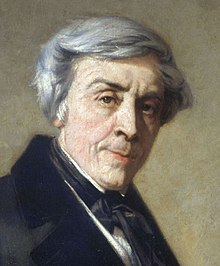
Back Jules Michelet AN جول ميشليه Arabic جول ميشليه ARZ ژول میشله AZB Жуль Мішле Byelorussian Жул Мишле Bulgarian Jules Michelet Catalan ژوول میشلێ CKB Jules Michelet Czech Jules Michelet Welsh
Jules Michelet | |
|---|---|
 Detail of a portrait by Thomas Couture, c. 1865 | |
| Born | 21 August 1798 Paris, France |
| Died | 9 February 1874 (aged 75) Hyères, France |
| Alma mater | University of Paris |
| Occupations |
|
| Spouses |
|
| Era | Modern philosophy |
| Region | Western philosophy |
| School | Anti-clericalism Freethought Republicanism |
Main interests | French history |
Jules Michelet (French: [ʒyl miʃlɛ]; 21 August 1798 – 9 February 1874)[3] was a French historian and writer. He is best known for his multivolume work, Histoire de France (History of France),[4] which is considered a foundational text in modern historiography. Michelet was influenced by Giambattista Vico; he admired Vico's emphasis on the role of people and their customs in shaping history, which was a major departure from the emphasis on political and military leaders.[5] Michelet also drew inspiration from Vico's concept of the "corsi e ricorsi", or the cyclical nature of history, in which societies rise and fall in a recurring pattern.
In Histoire de France, Michelet coined the term Renaissance (meaning "rebirth" in French) as a period in Europe's cultural history that reflected a clear break away from the Middle Ages. This subsequently created a modern understanding of humanity and its place in the new, "re-birthed" world. The term "rebirth" and its association with the Renaissance can be traced to a work published in 1550 by the Italian art historian Giorgio Vasari. Vasari used the term to describe the advent of a new manner of painting that began with the work of Giotto, as the "rebirth (rinascita) of the arts". Michelet thereby became the first historian to use and define the French translation of the term, Renaissance,[6] to identify the period in Europe's cultural history that followed the Middle Ages.[7]
Historian François Furet described Histoire de France as "the cornerstone of revolutionary historiography" and "a literary monument."[8]
- ^ Van der Veen, Wouter. "From Michelet to Gauguin: Van Gogh's literary mind". Van Gogh Museum Journal. Retrieved 15 July 2023.
- ^ De Bruijn, Jan (2004). Groen van Prinsterer in Europese context. Hilversum: Verloren. p. 12.
- ^ Cite error: The named reference
EB1911was invoked but never defined (see the help page). - ^ Michelet, Jules. History of France, trans. G. H. Smith (New York: D. Appleton, 1847)
- ^ Wilson, Edmund (1940). To the Finland Station: A study in the writing and acting of History.
- ^ Murray, P. and Murray, L. (1963) The Art of the Renaissance. London: Thames & Hudson (World of Art), p. 9. ISBN 978-0-500-20008-7
- ^ Brotton, Jerry (2002). The Renaissance Bazaar. Oxford University Press. pp. 21–22.
- ^ François Furet, Revolutionary France 1770–1880 (1992), p. 571